Securing AWS CloudFront Content with Lambda@Edge and Azure EntraID
 Raul Naupari
Raul Naupari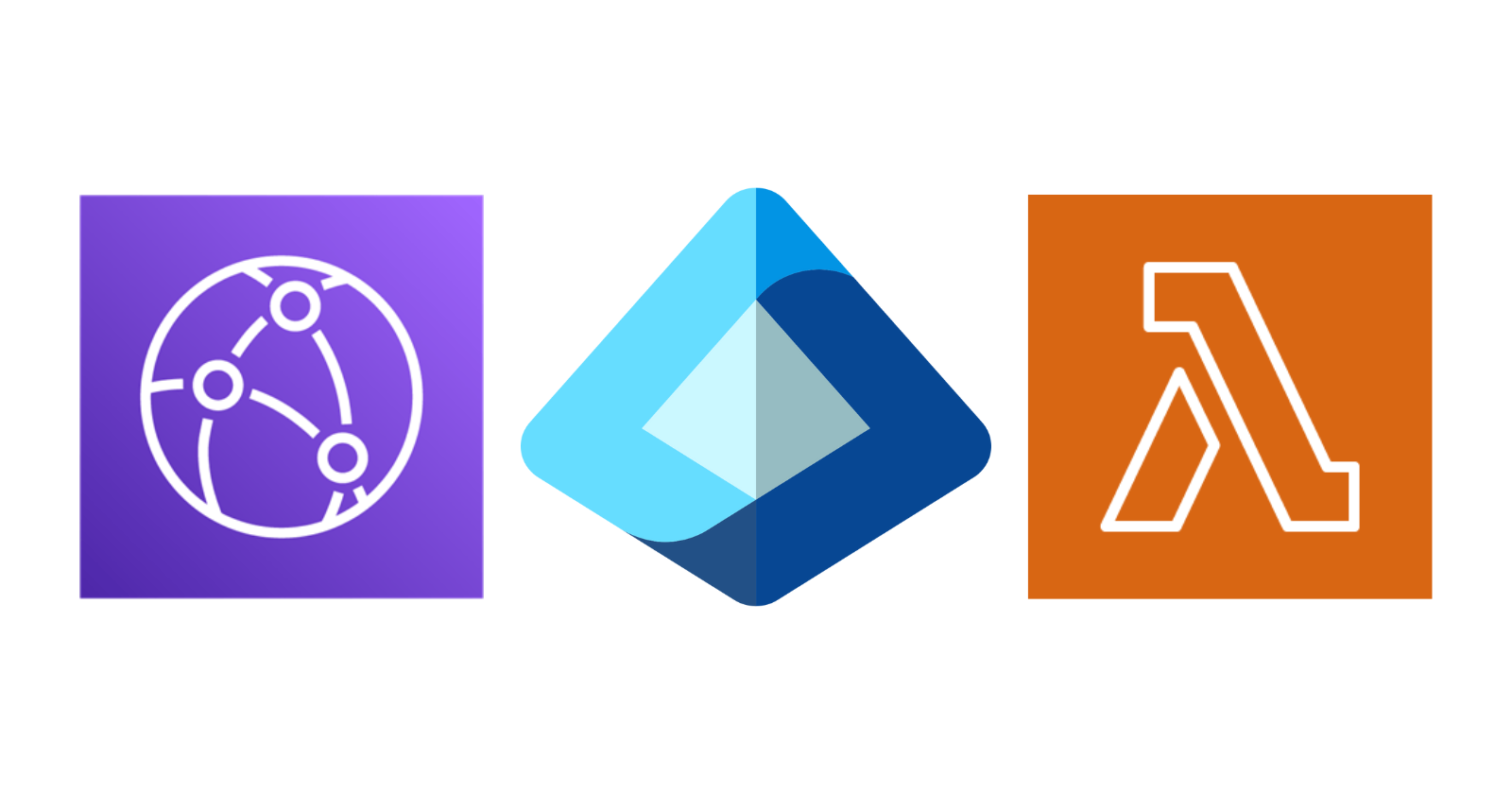
A everyday use case for AWS CloudFront, with Amazon Simple Storage Service (S3) as the origin, is hosting a Single Page Application (SPA). This method offers the benefits of serverless hosting, mainly lower costs. However, there's a downside: even though the SPA only allows access to valid users, any unauthenticated user can download the source code. A malicious user could look at the source code to understand the SPA's functionality and identify backend API endpoints, making it easier for them to launch attacks.
In this article, we focus on preventing unauthenticated users from downloading the SPA's source code by using Lambda@Edge functions, Azure Entra ID, and the Authorization Code Flow with PKCE. The image below summarizes the entire solution:
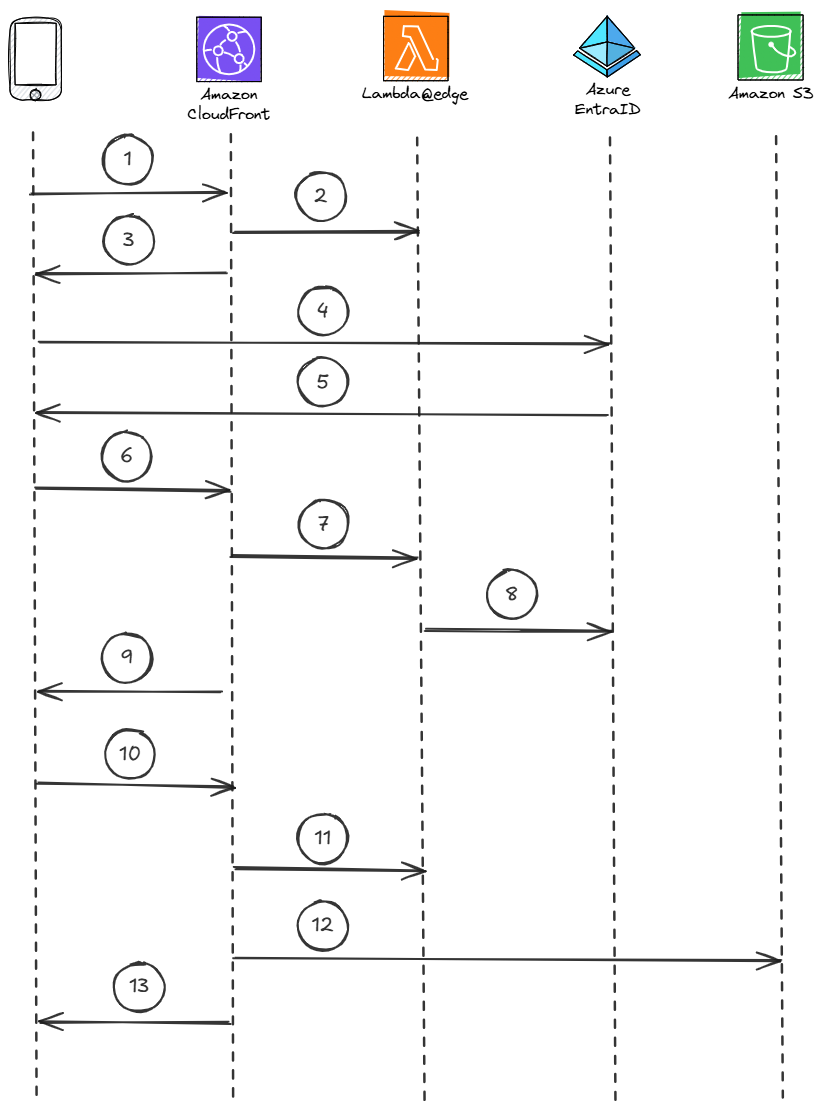
The user's browser sends a request to the
/path.AWS CloudFront uses the
check_authLambda@edge function to look for theaccess_tokenandrefresh_tokencookies in the request.Since the cookies are not present, AWS CloudFront responds by redirecting the browser to Azure EntraID, creating the
code_verifiercookie in the process.Azure EntraID prompts the sign-in form.
The user enters their credentials, and once authenticated, Azure EntraID redirects the browser to AWS CloudFront.
The user's browser sends a request to the
/callbackpath.AWS CloudFront invokes the
handle_callbackLambda@edge function.The Lambda@Edge function exchanges the authorization code for Azure EntraID's access and refresh tokens.
AWS CloudFront responds by redirecting the browser to the
/path, creating theaccess_tokenandrefresh_tokencookies in the process.The user’s browser sends a request to the
/path.AWS CloudFront repeats the process described in step 2 and also validates the access token.
Now that the cookies are present and the access token is valid, AWS CloudFront grants access to the resource in the S3 bucket.
The browser downloads the resource from AWS CloudFront.
What does Lambda@Edge?
Lambda@Edge enables us to run AWS Lambda functions at AWS CloudFront's edge locations, allowing real-time modification of requests and responses. This powerful feature enables the manipulation at four points in the AWS CloudFront request/response cycle:
Viewer Request: This occurs when AWS CloudFront receives a request from a client before cache checking.
Origin Request: This takes place before AWS CloudFront forwards the request to the origin. The function is bypassed if the resource is already cached.
Origin Response: This happens when AWS CloudFront receives the origin's response before caching the resource.
Viewer Response: This occurs just before AWS CloudFront sends the response back to the client.
While Lambda@Edge provides great flexibility, it operates under several important restrictions:
Only a specific version of a function can be used.
Functions must be located in the US East region.
Functions must be completed within 5 seconds for viewer triggers and 30 seconds for origin triggers.
Environment variables are not supported.
Layers are not supported.
Supported runtimes are limited to Node.js and Python.
A maximum of 128 MB of memory is allowed per function for viewer triggers and 10 GB for origin triggers.
Now, let's set up a solution to secure our AWS CloudFront resources using Lambda@Edge and Azure Entra ID.
Pre-requisites
An IAM User with programmatic access.
Install AWS CLI.
Install AWS SAM CLI.
Ensure you have an Azure Account
Node.js installed
App Registration
Let's create the app registration for our SPA:

Go to the Expose an API option and click Add a scope:
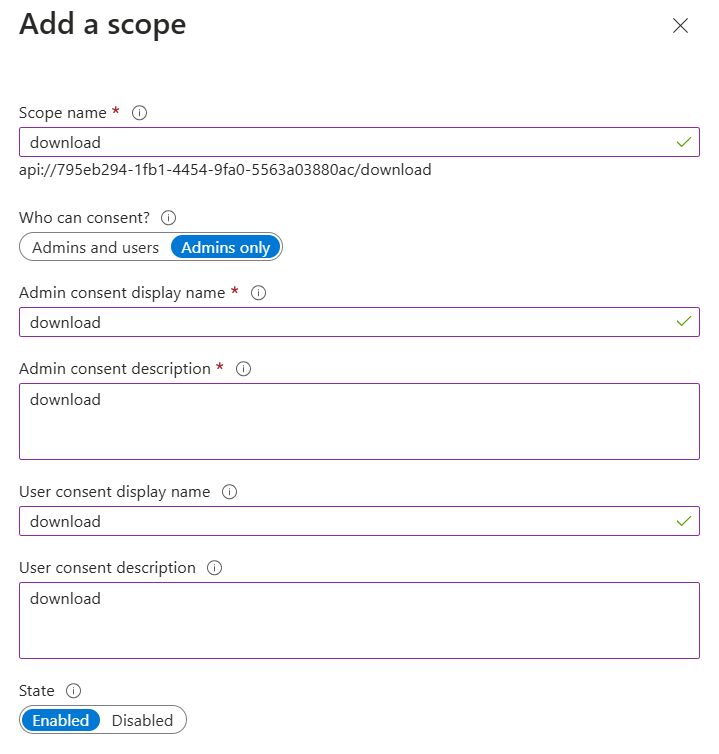
Go to the API permissions option, click Add a permission, select APIs my organization uses, and search for My SPA:
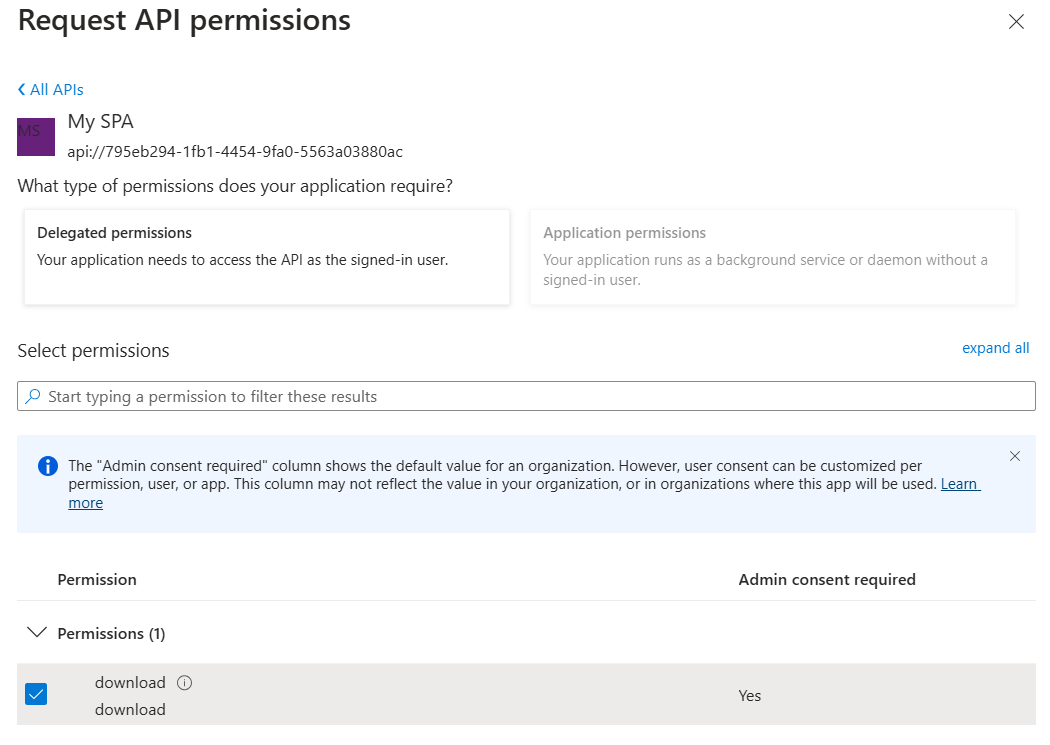
There is a missing step, which is setting up the Platform for this App Registration. We will add that once we have the domain for our application.
Lambda@Edge Functions
Create the functions/check-auth/index.mjs file with the following content:
import crypto from 'crypto';
import jwt from 'jsonwebtoken';
import jwksClient from 'jwks-rsa';
const TENANT_ID = '<MY_TENANT_ID>';
const CLIENT_ID = '<MY_CLIENT_ID>';
export const Handler = async (event, context) => {
const request = event.Records[0].cf.request;
console.info(request);
const cookies = parseCookies(request.headers.cookie || []);
if(cookies.access_token && cookies.refresh_token){
try {
const verifiedToken = verifyToken(cookies.access_token);
if(verifiedToken)
{
return request;
}
} catch (error) {
console.error('Verify token error:', error.name, error.message);
if (error.name=='TokenExpiredError') {
const newtokens = await exchangeRefreshToken(cookies.refresh_token, request.headers.host[0].value);
if(newtokens){
redirectToRoot(newtokens);
}
}
}
}
return redirectToAzure(request.headers.host[0].value);
};
function redirectToRoot(tokens)
{
return {
status: '302',
headers: {
location: [
{ key: 'Location', value: '/' }
],
'set-cookie': [
{ key: 'Set-Cookie', value: `access_token=${tokens.access_token}; Path=/; Secure; HttpOnly` },
{ key: 'Set-Cookie', value: `refresh_token=${tokens.refresh_token}; Path=/; Secure; HttpOnly` }
]
}
};
}
function redirectToAzure(domainName){
console.info("Redirecting to Azure...");
const codeVerifier = crypto.randomBytes(32).toString('base64').replace(/\+/g, '-').replace(/\//g, '_').replace(/=/g, '');
const codeChallenge = crypto.createHash('sha256').update(codeVerifier).digest('base64').replace(/\+/g, '-').replace(/\//g, '_').replace(/=/g, '');
const state = crypto.randomBytes(16).toString('hex');
const authUrl = `https://login.microsoftonline.com/${TENANT_ID}/oauth2/v2.0/authorize?` +
`client_id=${CLIENT_ID}` +
`&response_type=code` +
`&redirect_uri=${encodeURIComponent(`https://${domainName}/callback`)}` +
`&scope=${encodeURIComponent(`openid profile email api://${CLIENT_ID}/download`)}` +
`&code_challenge=${encodeURIComponent(codeChallenge)}` +
`&code_challenge_method=S256` +
`&state=${encodeURIComponent(state)}` +
`&response_mode=query`;
const response = {
status: '302',
statusDescription: 'Found',
headers: {
location: [{
key: 'Location',
value: authUrl
}],
'set-cookie': [{
key: 'Set-Cookie',
value: `code_verifier=${codeVerifier}; Path=/; Secure; HttpOnly; SameSite=Lax; Max-Age=600`
}]
}
};
return response;
}
async function verifyToken(access_token){
console.info("Verifying token...");
const client = jwksClient({jwksUri: `https://login.microsoftonline.com/${TENANT_ID}/discovery/v2.0/keys`});
const decoded = jwt.decode(access_token, { complete: true });
if(!decoded){
console.error('Decode token error');
return null;
}
const key = await client.getSigningKey(decoded.header.kid);
return jwt.verify(access_token, key.getPublicKey(), {
audience: `api://${CLIENT_ID}`,
issuer: `https://sts.windows.net/${TENANT_ID}/`,
algorithms: ["RS256"]
});
}
async function exchangeRefreshToken(refresh_token, domainName) {
console.info("Refreshing token...");
const url = `https://login.microsoftonline.com/${TENANT_ID}/oauth2/v2.0/token`;
const body = new URLSearchParams({
client_id: CLIENT_ID,
grant_type: 'refresh_token',
refresh_token: refresh_token
});
const response = await fetch(url, {
method: 'POST',
headers: {
'Content-Type': 'application/x-www-form-urlencoded',
'Origin': `https://${domainName}`
},
body: body
});
if (!response.ok) {
console.error('Exchange refresh token error:', response.status);
return null;
}
return await response.json();
}
function parseCookies(cookieHeaders) {
const cookies = {};
if (!cookieHeaders || !cookieHeaders.length) {
return cookies;
}
cookieHeaders.forEach(header => {
if (header.value) {
header.value.split(';').forEach(cookie => {
const parts = cookie.trim().split('=');
if (parts.length >= 2) {
cookies[parts[0].trim()] = parts.slice(1).join('=');
}
});
}
});
return cookies;
}
This function intercepts the viewer's request and tries to extract the access_token and refresh_token from the cookies, then executes the following logic:
If both tokens are present:
Attempt to verify the access token.
If verification succeeds, return the original request.
If the token is expired, attempt to get new tokens using the refresh token.
If the refresh is successful, redirect to the root with the new tokens stored in the cookies.
If the tokens are absent or the refresh fails:
- Redirect to the Azure EntraID login page to initiate the authorization code flow with PKCE.
To start the Node project, run npm init. Next, install the required dependencies by executing npm install --save jwks-rsa and npm install jsonwebtoken. Then, create the functions/handle-callback/index.mjs file with the following content:
const TENANT_ID = '<MY_TENANT_ID>';
const CLIENT_ID = '<MY_CLIENT_ID>';
export const Handler = async (event, context) => {
const request = event.Records[0].cf.request;
console.info(request);
const queryParams = request.querystring ? Object.fromEntries(new URLSearchParams(request.querystring)) : {};
const cookies = parseCookies(request.headers.cookie || []);
if(queryParams.code && cookies.code_verifier)
{
const tokens = await exchangeCode(queryParams.code, cookies.code_verifier, request.headers.host[0].value);
if(tokens){
return redirectToRoot(tokens);
}
}
return returnError();
};
function returnError()
{
return {
status: '400',
statusDescription: 'Bad Request',
headers: {
'content-type': [{
key: 'Content-Type',
value: 'text/html'
}]
},
body: '<html><body><h1>Error</h1><p>Authentication error</p></body></html>'
};
}
function redirectToRoot(tokens)
{
return {
status: '302',
headers: {
location: [
{ key: 'Location', value: '/' }
],
'set-cookie': [
{ key: 'Set-Cookie', value: `access_token=${tokens.access_token}; Path=/; Secure; HttpOnly` },
{ key: 'Set-Cookie', value: `refresh_token=${tokens.refresh_token}; Path=/; Secure; HttpOnly` }
]
}
};
}
async function exchangeCode(code, codeVerifier, domainName) {
console.info("Exchanging code...");
const url = `https://login.microsoftonline.com/${TENANT_ID}/oauth2/v2.0/token`;
const body = new URLSearchParams({
client_id: CLIENT_ID,
grant_type: 'authorization_code',
code: code,
redirect_uri: `https://${domainName}/callback`,
code_verifier: codeVerifier
});
const response = await fetch(url, {
method: 'POST',
headers: {
'Content-Type': 'application/x-www-form-urlencoded',
'Origin': `https://${domainName}`
},
body: body
});
if (!response.ok) {
console.error('Exchange code error:', response.status);
return null;
}
return await response.json();
}
function parseCookies(cookieHeaders) {
const cookies = {};
if (!cookieHeaders || !cookieHeaders.length) {
return cookies;
}
cookieHeaders.forEach(header => {
if (header.value) {
header.value.split(';').forEach(cookie => {
const parts = cookie.trim().split('=');
if (parts.length >= 2) {
cookies[parts[0].trim()] = parts.slice(1).join('=');
}
});
}
});
return cookies;
}
This function handles the callback from Azure EntraID. It attempts to extract the authorization code parameter and the code_verifier cookie, then proceeds with the following steps:
If both are present:
Exchange the
codefor access and refresh tokens.If successful, redirect to the root path with tokens set as secure cookies.
If either the
codeorcode_verifieris missing or if the exchange fails:- Display an error page.
To start the Node project, run npm init. Create the functions/template.yaml file with the following content:
AWSTemplateFormatVersion: '2010-09-09'
Transform: AWS::Serverless-2016-10-31
Description: >
AWS SAM
Resources:
MyAuthFunction:
Type: AWS::Serverless::Function
Properties:
Timeout: 5
MemorySize: 128
CodeUri: check-auth/
Handler: index.Handler
Role: !GetAtt MyLambdaFunctionRole.Arn
Runtime: nodejs20.x
AutoPublishAlias: live
Architectures:
- x86_64
MyCallbackFunction:
Type: AWS::Serverless::Function
Properties:
Timeout: 5
MemorySize: 128
CodeUri: handle-callback/
Handler: index.Handler
Role: !GetAtt MyLambdaFunctionRole.Arn
Runtime: nodejs20.x
AutoPublishAlias: live
Architectures:
- x86_64
MyLambdaFunctionRole:
Type: AWS::IAM::Role
Properties:
AssumeRolePolicyDocument:
Version: '2012-10-17'
Statement:
- Effect: Allow
Principal:
Service:
- 'lambda.amazonaws.com'
- 'edgelambda.amazonaws.com'
Action:
- 'sts:AssumeRole'
ManagedPolicyArns:
- 'arn:aws:iam::aws:policy/service-role/AWSLambdaBasicExecutionRole'
Outputs:
AuthArn:
Description: Auth Lambda edge ARN
Value: !Ref MyAuthFunction.Version
CallbackArn:
Description: Callback Lambda edge ARN
Value: !Ref MyCallbackFunction.Version
The file above will create both AWS Lambda functions with the necessary permissions and automatically publish a new version with each deployment. Run the following commands in the functions folder to deploy the resources to AWS, and remember to select us-east-1 as the region:
sam build
sam deploy --guided
AWS CloudFront
Create the cloudfront/template.yaml file with the following content:
AWSTemplateFormatVersion: '2010-09-09'
Transform: AWS::Serverless-2016-10-31
Description: >
SAM
Resources:
MyBucket:
Type: AWS::S3::Bucket
Properties:
BucketName: "<MY_BUCKET_NAME>"
PublicAccessBlockConfiguration:
BlockPublicAcls: true
BlockPublicPolicy: true
IgnorePublicAcls: true
RestrictPublicBuckets: true
MyCloudFrontOriginAccessControl:
Type: AWS::CloudFront::OriginAccessControl
Properties:
OriginAccessControlConfig:
Name: !Sub "OAC for ${MyBucket}"
OriginAccessControlOriginType: s3
SigningBehavior: always
SigningProtocol: sigv4
MyCloudFrontDistribution:
Type: AWS::CloudFront::Distribution
DependsOn:
- MyBucket
Properties:
DistributionConfig:
Origins:
- DomainName: !GetAtt MyBucket.DomainName
Id: !Sub "origin-${MyBucket}"
S3OriginConfig:
OriginAccessIdentity: ""
OriginAccessControlId: !GetAtt MyCloudFrontOriginAccessControl.Id
Enabled: "true"
PriceClass: "PriceClass_200"
IPV6Enabled : "false"
DefaultRootObject: index.html
ViewerCertificate:
CloudFrontDefaultCertificate: true
DefaultCacheBehavior:
AllowedMethods:
- DELETE
- GET
- HEAD
- OPTIONS
- PATCH
- POST
- PUT
CachedMethods :
- GET
- HEAD
Compress: true
TargetOriginId: !Sub "origin-${MyBucket}"
ForwardedValues:
QueryString: false
Cookies:
Forward: none
ViewerProtocolPolicy: redirect-to-https
LambdaFunctionAssociations:
- EventType: viewer-request
LambdaFunctionARN: <MY_CHECK_AUTH_FUNCTION_ARN>
CacheBehaviors:
- PathPattern: /callback
TargetOriginId: !Sub "origin-${MyBucket}"
ViewerProtocolPolicy: redirect-to-https
ForwardedValues:
QueryString: false
Cookies:
Forward: none
LambdaFunctionAssociations:
- EventType: viewer-request
LambdaFunctionARN: <MY_HANDLE_CALLBACK_FUNCTION_ARN>
MyBucketPolicy:
Type: AWS::S3::BucketPolicy
Properties:
Bucket: !Ref MyBucket
PolicyDocument:
Version: 2008-10-17
Statement:
- Action:
- 's3:GetObject'
Effect: Allow
Principal:
Service: cloudfront.amazonaws.com
Resource: !Sub "${MyBucket.Arn}/*"
Condition:
StringEquals:
AWS:SourceArn: !Sub "arn:aws:cloudfront::${AWS::AccountId}:distribution/${MyCloudFrontDistribution.Id}"
Outputs:
CloudFrontURL:
Description: URL of CloudFront distribution.
Value: !GetAtt MyCloudFrontDistribution.DomainName
The file above sets up an AWS CloudFront distribution linked with two AWS Lambda@Edge functions:
The
check-authfunction is triggered for all viewer requests in the default behavior.The
handle-callbackfunction is triggered for viewer requests matching the/callbackpath pattern.
Run the following commands in the cloudfront folder to deploy the resources to AWS:
sam build
sam deploy --guided
Create the cloudfront/site/index.html file with the following content:
<!DOCTYPE html>
<html lang="en">
<head>
<meta charset="UTF-8">
<meta name="viewport" content="width=device-width, initial-scale=1.0">
<title>Under Construction</title>
<style>
body {
font-family: Arial, sans-serif;
background-color: #f3f3f3;
margin: 0;
padding: 0;
display: flex;
justify-content: center;
align-items: center;
height: 100vh;
}
.container {
max-width: 600px;
padding: 20px;
background-color: #fff;
border-radius: 8px;
box-shadow: 0 0 10px rgba(0, 0, 0, 0.1);
text-align: center;
animation: pulse 1.5s infinite alternate;
}
@keyframes pulse {
0% {
transform: scale(1);
}
100% {
transform: scale(1.05);
}
}
h1 {
color: #333;
}
p {
color: #666;
margin-bottom: 20px;
}
</style>
</head>
<body>
<div class="container">
<h1>Under Construction</h1>
<p>We're working hard to bring you something awesome!</p>
<p>In the meantime, please excuse our appearance as we're in the process of building something amazing. Stay tuned for updates.</p>
<p>Thank you for your patience!</p>
</div>
</body>
</html>
Deploy our application to AWS S3 by running the following command:
aws s3 sync '.\cloudfront\site' s3://<MY_BUCKET_NAME>
Callback URL
At this point, we can complete the app registration. Go to our App Registration, select the Authentication option, click Add a platform, and choose Single-page application.
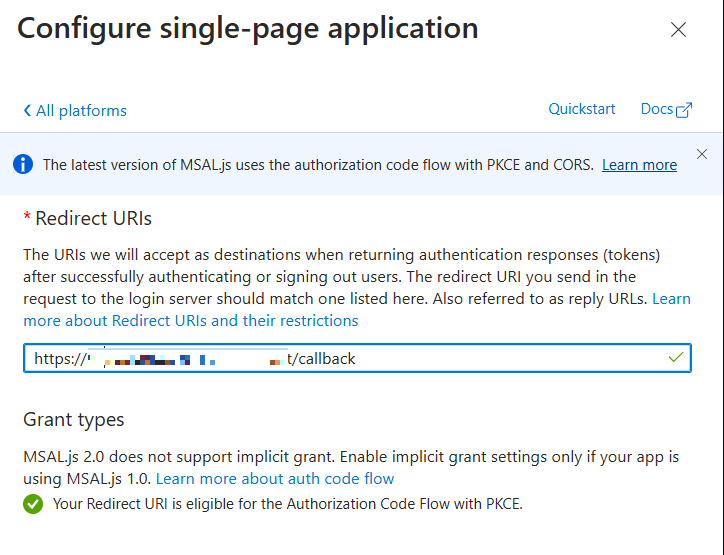
Navigate to our AWS CloudFront URL and start using the application. All the code can be found here. Thanks, and happy coding.
Subscribe to my newsletter
Read articles from Raul Naupari directly inside your inbox. Subscribe to the newsletter, and don't miss out.
Written by

Raul Naupari
Raul Naupari
Somebody who likes to code